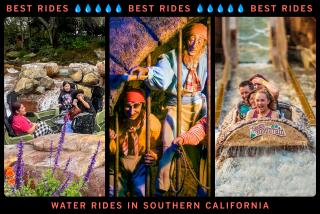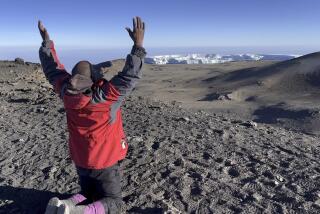In Zambia, a safari means going with the flow
- Share via
Reporting from Livingstone, Zambia — Less than an hour after stepping off the airplane in Livingstone, I had already witnessed elephants drinking from the mighty Zambezi River, watched baboons monkeying around on an ivory beach and stared down a bloat of hippos soaking on a sandbar.
These kinds of encounters would become routine during a 10-day water-centric Zambian safari.
Many African wildlife safaris are land-based, but my family and I, as aquaphiles, structured ours around the rivers of this landlocked country.
We love bodies of water, swimming, diving, surfing and rowing on them. We chose Zambia — on the advice of veteran guide Michael Lorentz, chief executive of Passage to Africa — because it was away from the crowds at such popular safari sites as South Africa’s Kruger National Park or Kenya’s Maasai Mara National Reserve.
Our trip would take us first to Livingstone, then to the 1,580-square-mile Lower Zambezi National Park (site of Sausage Tree, our temporary home and one of only seven camps), and finally down to the South Luangwa River Valley, the birthplace of walking safaris. We toured in aluminum speedboats and canoes, sometimes sailing alongside dried-up riverbeds in a specially modified Land Cruiser, rarely seeing another soul.
MORE AFRICA: Namibia is far from traditional driving safaris »
Instead of people, we came across crocodiles gliding through the water, their knobby heads only half visible, and elephants using their tusks to shake the seed pods (nicknamed elephant rattles) out of winter thorn trees, then sucking them up with their vacuum-like trunks.
As the sun shaded the sky gold, Steven, our guide in South Luangwa, delivered us to a handful of director’s chairs on a sandy waterfront.
Our entertainment: hundreds of carmine bee-eaters — small, fast birds with coral breasts, crimson wings, jade heads and cerulean tails — engaged in aerial acrobatics above the riverbank where they nest.
We hopped a pontoon boat and “went out for lunch,” dining on couscous-crusted tilapia on Wedding Island, one of the Zambezi’s little land masses.
In the steaming middays at Sausage Tree, we found relief in the infinity pool, watching water buffaloes roam across the river and elephants cross into our “front yard.”
Bilimungwe, an eco-friendly camp where we stayed later, had no electricity, so we drenched our kikois and, wrapped in these East African sarongs, sprawled on lounge chairs above the watering hole, waiting for a breeze. (The elephants, meanwhile, stayed cool by bathing in muddy holes.)
After 10 days, I craved more. I was hooked.
It’s all about Zambia
Defying preconceived notions, Zambia has a relatively placid history, and this year, the Global Peace Index declared it the most peaceful country on the continent.
Although Zambia is landlocked — it’s surrounded by the Democratic Republic of the Congo, Tanzania, Malawi, Mozambique, Zimbabwe, Botswana, Namibia and Angola — it’s plenty wet.
The border with Zimbabwe is the rushing Zambezi River, known as the Mighty Zambezi.
At 1,600 miles, the fourth-largest river in Africa traverses six countries. Its crown jewel: the deafening, rainbow-producing Victoria Falls, also split between Zambia and Zimbabwe.
In 1855, Scottish explorer David Livingstone named the enormous waterfall for Queen Victoria. (Nearby Livingstone is named for him.)
But as early as the 1800s the indigenous Kololo tribe called it Mosi-oa-Tunya, or “Smoke That Thunders.”
MORE AFRICA: Tanzania’s Tinga Tinga style »
Until 1964 the Republic of Zambia was under British rule — as a protectorate it was called Northern Rhodesia — and English is still the national language. The transition to independence, remarkably, was peaceful
Copper mining is a major industry and the metal is still Zambia’s principal export. But about 60% of the population lives below the poverty line, and 14.3% of adults are HIV positive.
Beyond its considerable wealth in minerals (cobalt, coal, gold and gemstones are also mined), Zambia is rich in natural beauty and exotic wildlife. Thirty percent of the country is reserved for the latter in 20 national parks and 34 game management areas.
Life on the rivers
My father was a collegiate rower who still begins most days on the river. My mom did laps hours before giving birth to my sister, who swam before she walked and later broke records. My happy place is the ocean.
We are all about the water.
During our safari, water played an integral role in the experience. In the water — or on the river banks, the animals really came alive for us.
Sunset cruises on the Zambezi are spectacular unknown experiences. With a gin and tonic in hand — always a gin and tonic — we shot past leaping impala and saw thousands of hippos, which ducked below the surface (they can hold their breath for six minutes, more in panic mode), popping back up and occasionally showing off their impressive jaws by yawning.
Water also was the backdrop for our most heart-stopping experience. After landing in Livingstone, we headed for Victoria Falls, about midway in the river’s rush to the Indian Ocean.
On a guided trek my sister, Hollyn, and I clung to each other as we slid into the rushing Devil’s Pool infinity pond at the edge of the 335-foot-high falls.
They were so powerful it seemed likely that one of us could go over the side into the crushing water and double rainbows below. Instead, the current carried us up to the thick wall of rock that, like the edge of a swimming pool, kept us from pouring over.
Perhaps our most memorable encounters involved canoes. We traversed the 8.2-mile Chifungula Channel, which guide Ryan promised was the best calm-water paddling on the continent.
Saddle-billed storks, Egyptian ducks, sacred ibis, great white egret, white clown lapwing and common bee eaters, in an array of Technicolor hues, flapped, swam and fished around us as we glided down the hippo-rich waters almost at eye level with the curious creatures.
All was serene, until it wasn’t. A startled hippo, apparently startled by our presence, emerged from the bank and did a 2 1/2-ton belly flop, landing inches from my mom’s canoe. It created a wake that rocked our canoes and left us gasping.
The hippo was even more scared than we, and it fled.
Several miles in we came upon the social event of the week, a gathering of 30-plus elephants.
It was like an extended-family picnic, complete with babies and mamas splashing and spraying water, and a happy crew eating lunch while drunk uncles stomped their feet and mock-charged each other to prove their manhood.
For them it was another day on the river. For us, it was a story to tell again and again.
If you go
THE BEST WAY TO LIVINGSTONE, ZAMBIA
From LAX, American, Jet Blue, Delta and Virgin Atlantic offer connecting service (change of planes) on South African to Johannesburg, South Africa. South African and British offer nonstop service to Livingstone. Restricted round-trip fares from $1,661, including taxes and fees.
WHERE TO STAY
The River Club, Farm 1519A Nakatindi Road, Livingstone. A historic and charming farm-turned-lodge that opened its 11 elegant luxury suites in 1997. Doubles from $440 a night per person, including breakfast.
Sausage Tree Camp, Lower Zambezi National Park, Zambia. An intimate, all-inclusive safari camp with Bedouin-style tents (chose the dreamy Kigelia House with an infinity-edge pool overlooking the river), impeccable cuisine and guiding, and an atmospheric riverside deck and fire pit. From $867 a night per person, all inclusive.
Bilimungwe Bush Camp, the Bushcamp Co., South Luangwa National Park, Zambia. Spacious wooden cabins nested around two mossy green watering holes drawing an exotic array of animals. Doubles $620 a night per person, all inclusive.
Chindeni, South Luangwa National Park, Zambia. A serene, airy four-“tent” luxury camp beside the Chayumba Lagoon, a several-hour bush walk from Bilimungwe. From $620/night per person sharing, all inclusive.
WHERE TO EAT
All our meals were included, but we journeyed out by boat for one standout experience.
The Elephant Cafe, Mosi-Oa-Tunya Gate, Livingstone. A cafe suspended over the Zambezi where guests feed rescued elephants before dining on a seasonal three-course menu prepared with locally sourced and foraged (some by elephants) ingredients. Three-course lunch $220 a person including elephant encounter, alcohol and jet-boat transfer.
WHAT TO KNOW
Safari outfitters offer strict guidelines about what to pack. Listening to the weight requirements is wise, but it’s not necessary to follow exactly the apparel guidelines—unless you want to look like you walked out of a safari-themed shop. Avoid the super bright colors (blue, pink, red), which could draw unwanted attention from the animals and from bugs.
I took a DSLR camera with an 18-270mm lens, Make sure you’re prepared with suitable equipment, because an iPhone won’t do enough. I used my camera’s zoom to watch animals, but a pair of binoculars would have been a smart purchase.
Zambia’s safari season begins in April and generally wraps up in October. Take cash (clean, crisp bills must be newer than 2006) for the entry visa ($50 a person) and for tipping staff at camps.
Twitter: @latimestravel
More to Read
Sign up for The Wild
We’ll help you find the best places to hike, bike and run, as well as the perfect silent spots for meditation and yoga.
You may occasionally receive promotional content from the Los Angeles Times.






